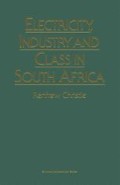Abstract
‘In South Africa you can never plan too big.’1 Over the next quarter of a century van der Bijl was proved right. By 1975 South Africa had the ability to build nuclear weapons, to manufacture Mach 2 fighter-bombers, to manufacture many of its basic heavy engineering requirements, and to manufacture many of its consumer goods. The compound system had been greatly refined and extended, while labour control had been computerised.2 Many of South Africa’s labour reserves were formally becoming independent states, but life there was characterised by malnutrition, starvation, and high infantile mortality.3 Low mining wages had enabled South Africa to become a major world supplier not only of gold and diamonds, but also of a vast range of base minerals, notably platinum, chrome, manganese, titanium, vanadium and, most importantly, uranium. South Africa had obtained the crucial technology of uranium enrichment. All of this, and especially the last, was dependent upon plentiful supplies of exceedingly cheap electricity.4 In the words of the Escom General Manager in 1976, ‘We’re still ridiculously cheap by world standards — probably half the unit price of most Western countries.’5 Escom power was cheap not only because Escom operated ‘without profit’ but also because its power-station compounds ensured cheap labour. Above all, its coal was cheap.
Access this chapter
Tax calculation will be finalised at checkout
Purchases are for personal use only
Preview
Unable to display preview. Download preview PDF.
Notes and References
South Africa, Report of the Department of Bantu Administration, (RP 21/1975) (Pretoria: GP, 1975) p. 10.
P. M. Leary and J. E. S. Lewis, ‘Some Observations on the State of Nutrition of Infants and Toddlers in Sekhukuniland’, SA Med J (18 Dec 1965) pp. 1157–8;
M. L. Neser, ‘Can we Eradicate Malnutrition in South Africa?’, SA Med J (18 Dec 1965) p. 1161.
Z. Cervenka and B. Rogers, The Nuclear Axis (London: Friedman, 1978).
D. G. Malherbe, ‘Union’s Potential’, SA Financial News and Times (2 Jun 1950).
D. B. Reay, ‘Production of Power in the Union of South Africa’, Fourth World Power Conference (London: Lund Humphries, 1950) p. 1190.
South Africa, Coal Shortages Commission, UG9/1952 (Pretoria: GP, 1952) p. 40.
UK, Economic Conditions in the Union of South Africa (1953) p. 34.
UK, Economic Conditions in the Union of South Africa (1953) p. 30.
A. M. Jacobs, ‘Plans to Meet South Africa’s Electric Power Needs’, Optima (Sep 1951) pp. 20, 22.
South Africa, Coal Shortages Commission, (UG9/1952) pp. 19, 40, 41.
A. M. Jacobs, Electric Power Supply, 1946, p. 7.
M. Gericke and W. Fenwick, ‘Economic Utilisation of Energy in the Gold Mines’, World Power Conference (Fourteenth Sectional Meeting 1964) pp. 2361–3.
C. S. McLean, ‘Vote of Thanks’, Trans SAIEE (Jan 1953) p. 19.
World Bank, Electric Power (Washington: World Bank, 1971) p. 3.
South Africa, BTI, ‘The Electrical Goods Manufacturing Industry’, Commerce and Industry (Dec 1952) p. 189.
N. T. van der Walt, ‘Advances In Power Generation Over the Last 75 Years’, SAMEJ (Feb 1968) p. 244.
English Electric Co. (SA), Extensions to the Benoni Works (Benoni: EEC [SA], 1958).
GEC (Pty) Ltd, GEC in South Africa 1903–53 (Parow: GEC, 1953).
Philips South Africa, 25 Years in South Africa 1929–54 (Johannesburg: Philips SA, 1954);
Philips Laboratorium, In Diens Van Die Toekoms (Johannesburg: Philips, 1958).
Siemens, Siemens in South Africa (Johannesburg: Siemens, 1966) p. 2.
W. M. de Beer, ‘Electrical Manufacturing Industry in South Africa’, Cigre Colloquium (Oct 1975) p. 1.
US, Industrial Developments in the Union of South Africa (Washington: Dept of Commerce, 1958) p. 1.
G. Masson, ‘The Supply of Electricity to Native Townships’, Proc MEUSA (1959) pp. 112–4.
Da Gama Publishers, The State of South Africa Yearbook, 1976 (Johannesburg: Da Gama, 1976) p. 172.
South Africa, Report of the Commission of Enquiry into the Application of Nuclear Power in South Africa (Pretoria: GP, 1960).
H. J. Simons, ‘Death in South African Mines’, Africa South (1961) p. 55.
Escom, Official Opening of the Camden Power Station (Johannesburg: Escom, 1967) p. 19.
E. H. Scholes, ‘Electricity Supply in South African Municipalities’, Cigre Colloqium (Oct 1975) p. 1.
Johannesburg, Annual Report of the Electricity Department, 1969, p. 1.
A. J. Levy, ‘Long-term Forecast of Load on Escom’s Interconnected System’ (Escom Library, Jun 1971) pp. 16–17.
K. Middlemas, Cabora Bassa (London: Weidenfeld & Nicolson, 1975).
H. Olivier, Great Dams in Southern Africa (Cape Town: Purnell, 1977) p. 76.
H. J. van Eck, quoted in Barclays National Review (Mar 1973) p. 13.
R. Christie, ‘The Political Economy of the Kunene River Hydro-Electric Schemes’ (MA Thesis, UCT, 1975) Ch. 4.
R. First, Black Gold: The Mozambican Miner, Proletarian and Peasant (Brighton: Harvester Press, 1983) p. 183.
W. G. Allinson, ‘High Voltage Electric Power Transmission Technology in the USSR’, CREES Discussion Paper (Mar 1975) p. 7.
F. C. Beriger et al, ‘Cabora Bassa HVDC Transmission’, IEE Trans PAS (May/June 1975) p. 1061.
E. F. Raynham, ‘The Cabora Bassa-Apollo Project’, Cigre Colloguium (Oct 1975) p. 1.
M. Shand, The Orange River (Kimberley: N. Cape Regional Development Association, n.d., c. 1959).
H. J. Simons ‘Harnessing the Orange River’ in Warren and Rubin (eds) Dams in Africa (London: Cass, 1968) p. 141.
D. F. Kokot, ‘Hydro Electric Power Possibilities in Southern Africa’, JSAIE (Jun 1949) p. 255.
M. Chennels, ‘The Economics of Pumped Storage — Steenbras’ (Seminar Paper, UCT, mimeo, 1976).
Calculated from South Africa, Censuses of Electricity, Gas and Steam, 1963–4 and 1972 (Pretoria: GP, 1968 and 1975) Tables 4 and 13, and 4.1 and 14, respectively.
Copyright information
© 1984 Renfrew Christie
About this chapter
Cite this chapter
Christie, R. (1984). Better than van der Bijl Dreamed: Escom, 1948–75. In: Electricity, Industry and Class in South Africa. St Antony’s Series. Palgrave Macmillan, London. https://doi.org/10.1007/978-1-349-07030-5_8
Download citation
DOI: https://doi.org/10.1007/978-1-349-07030-5_8
Publisher Name: Palgrave Macmillan, London
Print ISBN: 978-1-349-07032-9
Online ISBN: 978-1-349-07030-5
eBook Packages: Palgrave Social & Cultural Studies CollectionSocial Sciences (R0)

